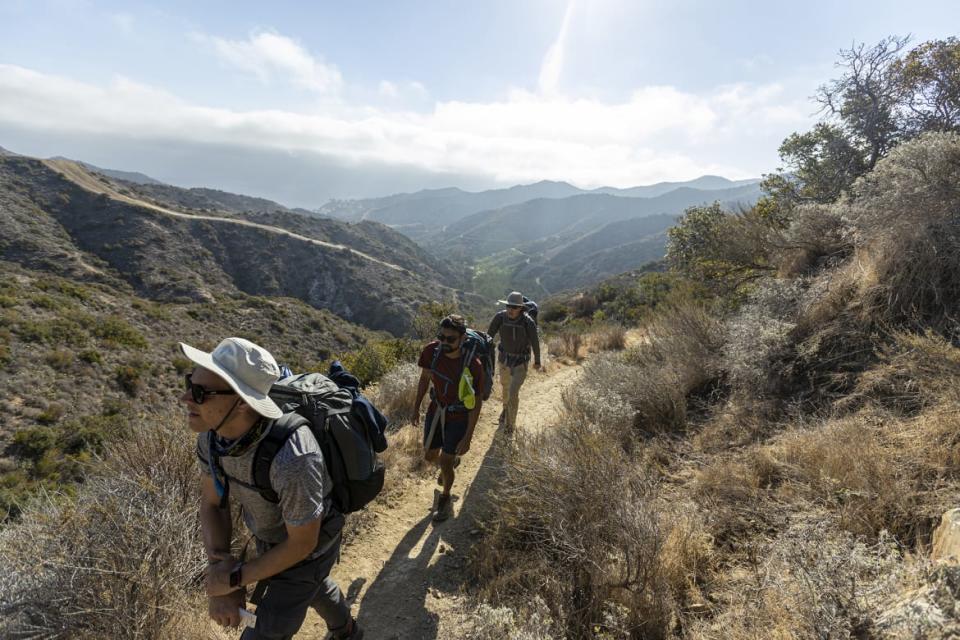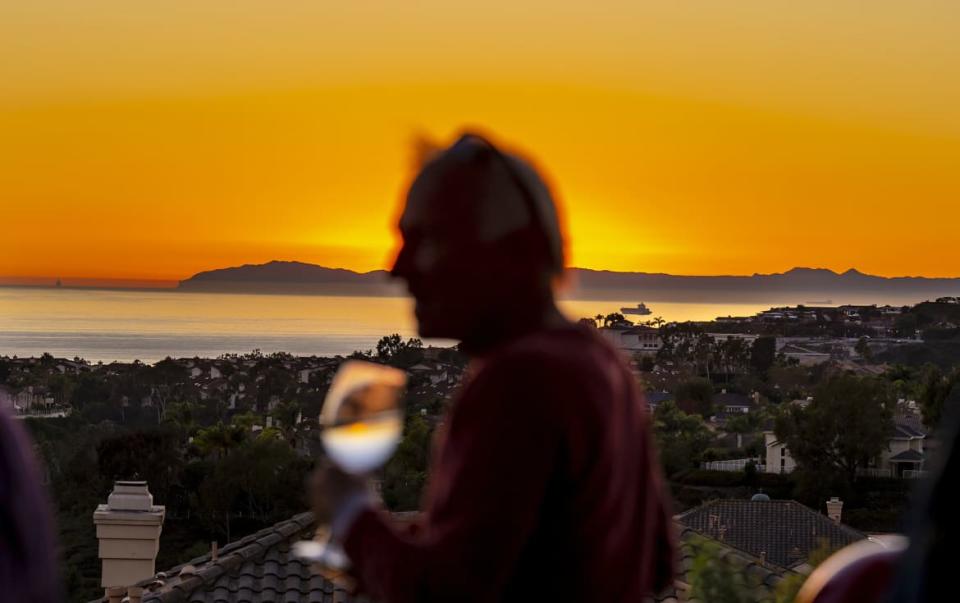The Oft-Forgotten California Islands Are Cooler Than You Imagine

It is a cliché-evoking, warm Southern California day, and I am precariously perched in a kayak off the coast of Santa Cruz Island, letting out a series of unholy high-pitched shrieks. A spotted seal has just jumped onto the rock next to me and to say I’m delighted by the visitor would be an understatement. He pauses a moment to take me in and then, unperturbed by my Harry Styles-fan cosplay, slips back into the dark blue water and disappears. While I also swooned at a passing bald eagle, and loved seeing a densely populated colony of nesting California Brown Pelicans (even though they smelled exactly like you’d expect), the brief seal encounter might be my favorite. It’s also one of the many reasons why Channel Islands National Park is the latest selection for our twice-a-month series on underrated destinations, It’s Still a Big World.
Like a lot of people, it took a global pandemic and societal shutdown for me to seek pleasures closer to home. But it was only while finalizing the two-day trip on Island Packers, the official ferry of the Channel Islands, did I realize how weird that was. Mainly, because it is difficult to believe that the Channel Islands could ever qualify as a well-kept secret—particularly since I grew up in Ventura, California. The port city takes a low-key pride in its national park, which on a clear day can be easily spotted just 12 miles into the Pacific Ocean. Businesses scattered across the area claim them as a namesake. Enough marathon swimmers cross the Santa Barbara Channel that there’s a society dedicated to making sure they do it safely. I even attended Juanamaria Elementary School, named for the Lone Woman of San Nicolas Island, a figure that also doubled as the main character in my favorite book, Island of the Blue Dolphins. (Even as an 8-year-old, being left alone for decades already appealed to my introvert fantasies.)

Hikers along the improved Trans-Catalina Trail.
But there were no science class trips out to the islands. It never sparked interest as a glorified girls’ day out. (I was probably too busy reading to care.) And the closest my family ever got was strolls around the Ventura Harbor for neon-colored ice cream at Costal Cone. When I told friends my plans for a pair of consecutive day trips, more than one thought that I was referring to the English Channel Islands. Certainly, not an off-base assumption given what I do for a living, but it does highlight just how far nature can feel from the city. It’s not just a case of locals ignoring what’s right in front of them. Unlike Nantucket, Martha's Vineyard, or Fire Island, they have simply not been enshrined in the travel lexicon.
First, some extremely quick background: The Channel Islands are comprised of Anacapa, San Miguel, Santa Cruz, Santa Rosa, San Clemente, San Nicolas, Santa Barbara, and Santa Catalina—eight islands that stretch across Santa Barbara, Ventura, and Los Angeles counties. The distance between them and their distance from shore (between 12 and 70 miles), means that each island tells a wildly different story, together comprising a sort of grab-bag history of the state. Originally inhabited by the Tongva and Chumash tribes, colonization came, first in the form of Spanish explorers in 1542, and then in a rotating musical chair of land ownership that included Chinese abalone fisher camps, ranchers, bootleggers, and—in the of the 19th century—anyone who could pay to lease land not already privately owned. In 1938 Santa Barbara and Anacapa were declared a national monument, with the other six Islands added to the designation in 1980.
And then…crickets. Well—almost. Today the Channel Islands are one of California’s least-visited national parks, with less than 500,000 yearly visitors. And while I might be proud of finally seeing a quarter of the islands, most visitors don’t even get that far. As Marla Daily, author of The Islapedia, an indexed resource on the Islands, and president of the Santa Cruz Island Foundation, explained to me, few people explore more than a fraction of the Channel Islands, an exclusivity they’re happy to maintain. Even Jacques Cousteau was denied filming rights on the islands out of fear that popularity would impact their pristine natural environment.

Beach-goers snorkel at Casino Point Dive Park on a summer day in Catalina Island.
“In 1994, I started The All 8 Club, for those who have set foot on all eight islands,” she explains. “There are 244 people who have done so, about 20 of whom have since died. It's the most exclusive recognized geographic club in the United States. There are far, far more people, tenfold more people, in the Seven Summits Club.”
In other words: I still have my work cut out for me.
I knew I’d need another trip almost as soon as our boat hit open water on the ride out to Santa Rosa. As Daily diplomatically pointed out when I asked her what her favorite location was, each island has a completely different spirit. But one thing that unites them is a sense of timelessness. Yes, you can walk by old ranching structures and school houses (or step inside for a quick history lesson), but beyond that, it’s you and nature. A lot of the same nature that you might have seen 10,000 years ago.
There are parallels to be made between the Galápagos Islands and Channel Islands—and not just because they were formed during a similar timeframe: 2,000 species live in the Channel Islands, and 150 can’t be found anywhere else. Better yet, it doesn’t take an excessive amount of exploration to see a large chunk of them. By the time we docked at Santa Rosa Island, I had already seen multiple schools of dolphins, and sea monster-worthy kelp that threaded through the clear harbor like an underwater art installation.
It only took a half a mile into the surprisingly gentle 3.5-mile Cherry Canyon Loop before I was completely surrounded by nature that made me question if I was still in direct proximity to my hometown. (Answer…kinda?) I snapped photos of the impressive large yellow swaths of the Island Paintbrush (aka ground covering/flower that goes by the more scientific name Castilleja mollis) and marveled at the Dr. Seuss worthy Giant Coreopsis (which looks like three different types of flowers precariously stacked on top of each other) as I navigated deeper into the cliff sides. Although the trail was marked as a moderate climb, it was fairly easy to navigate, even as someone with romcom-worthy lack of coordination. Yes, I did end up having to butt-scoot my way down the last 300 feet or so, but not before hitting the top of the mesa, where I was rewarded with a sweeping view of craggy cliffs. I grinned into the open ocean, and took a beat to adjust my ponytail, which had already been rendered a snarled mess in the wind.

A guest enjoys a glass of wine on the outdoor patio at the Bottega Angelina as the sun sets over Catalina Island.
(Practical note: The Channel Islands’ other major activity of note, camping, is also highly recommended—however, be sure to book as far out as possible, since it can be tricky to coordinate campsite and ferry reservations. And with all camping experiences, be sure to bring all the food, water, and supplies you might need—and then take everything with you when you leave.)
Hitting Santa Cruz Island the following day provided the same “wow nature!” rush. The largest of the Channel Islands at 22 miles long, it’s impossible to see it all on a four-hour day-trip timeslot. So, on the advice of my outdoor-savvy friend, who also graciously agreed to assuage my nerves by riding with me in a double kayak, we hit the water. Our two-hour adventure began from Scorpion Anchorage, a launching pad named for the Island’s extremely bashful population of actual scorpions that regulars only spot every decade or so—and only got more exciting from there.
Having already seen the Painted Cave, Santa Cruz’s most famous cave the day before on our ride home from Santa Rosa, I pushed through my hesitation to explore the smaller, barnacle-covered alcoves. Not only did I discover that encrusted with barnacles and filled with the wooshing sound of the ocean, they were just as cool as I would have expected (Goonies references were thrown around more than once), but once I relaxed, riding the tides began to feel like the ultimate amusement park ride.
Of course, children over the age of five regularly take these tours, so take my histrionics with a pinch of salt.
But as our kayaking guide Chuck Graham, a local writer, photographer, and local legend explained while we bobbled in the waves, going into the ocean can get wilder. Revealed with an expert’s sense of adventure, he’s had a few encounters with Great White sharks, including seeing fins some nine miles off the island while kayaking to work. Having just gotten over my initial squeamishness enough to dip my hand in the water and touch the feather boa and giant bladder kelp floating below the boat, I giggled nervously at his stories.
Back on land after an arm workout I’d feel the next day, and intensely sunburned shins I’d feel hours and weeks later, I felt deeply satisfied by the foray outside my comfort zone. I celebrated by digging into my packed lunch, while watching for the occasional electric blue flash of an Island Scrub Jay. Mostly I saw ravens, which Graham told us don’t just steal car keys, but also zip bags behind them—which given the fantastical nature of the islands, I readily believe.
But I was after the ultimate prize: spotting the Island Fox. Its Latin name is Urocyon littoralis santacruzae, but all you really need to know is that they’re flipping adorable. Think Disney-like renderings of smiling foxes roughly the size of house cats. And also on the day I visited, shockingly scarce given their regular attempts to scam forbidden snacks. (This is a good time to remind you to never give into wildlife demanding food, no matter how adorable.)
We paced the nearby trails, scanned the brush, and even asked other tourists, with no results. And then finally, with the clock run down to a mere 15 minutes before we’d have to catch a ferry home, my island bucket list was completed when a fox emerged from a patch over overgrown grass, and plopped down in the middle of a campsite—and I swear—began posing. A clutch of people gathered around it, and began silently taking photos, grinning at our good fortune over the top of our phones. As far as communal experiences and trip codas go, being brought together with strangers by an extremely cute creature ranks high. It’s something I hope I’ll be able to recreate on future trips.
But next time, I’m bringing extra sunscreen.
Get our top stories in your inbox every day. Sign up now!
Daily Beast Membership: Beast Inside goes deeper on the stories that matter to you. Learn more.

